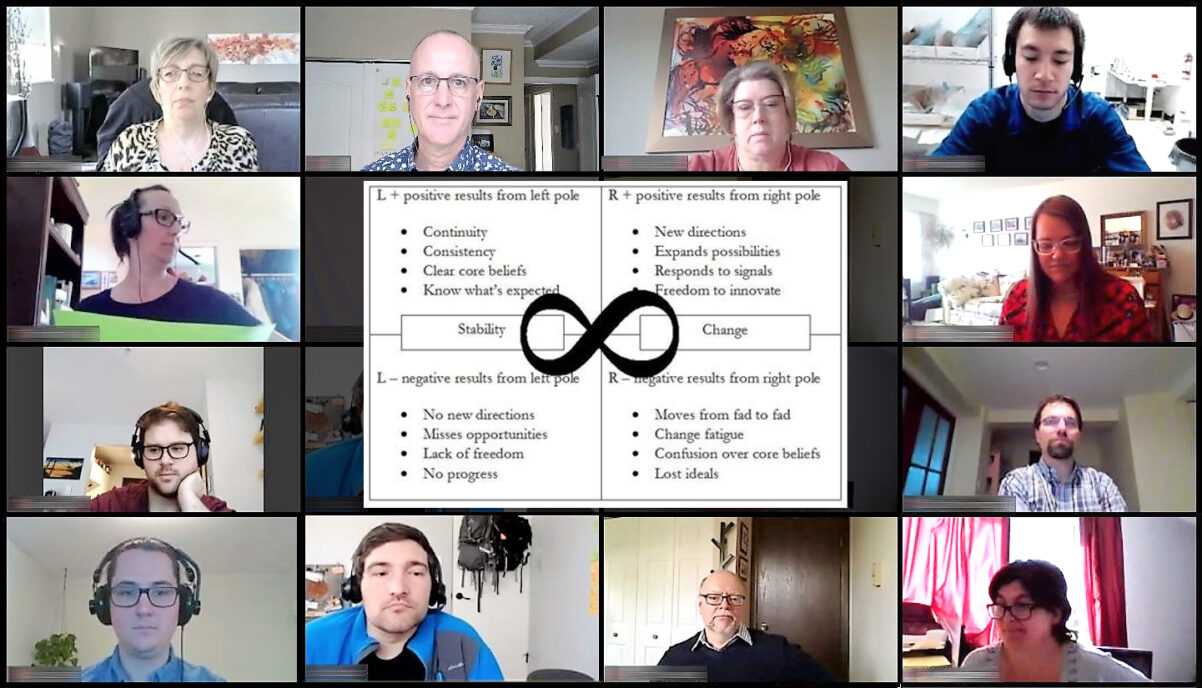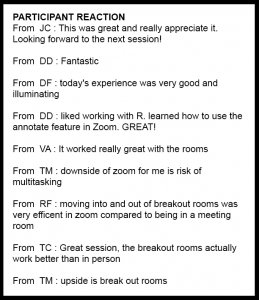
In-Person vs. Virtual Training: Comparing Results
Hidden In-Person vs. Virtual Training Benefits and Tips for COVID-19 and Beyond
In this COVID-19 time, while many of our clients were canceling training programs, StarFish Medical continues investing in their staff by offering the scheduled Polarity Management programs virtually.
In fact, my business partner and husband, Dave, and I were very appreciative we could take advantage of a unique opportunity to hold two versions of the same program. One had already been held in person and we transitioned the second to a virtual session on the Zoom platform. This blog shares the lessons learned about in-person vs. virtual training during that experience.
The first time I was challenged to provide a learning opportunity to people at a distance was in 1991. I was teaching a continuing education course for the University of Calgary and there were 25 participants from across Alberta. We were using audio teleconference technology, and I delivered the session from a studio on campus, assisted by someone who handled the technology.
At the time, I was skeptical that this could be an effective or enjoyable experience for them or me, but I was in the middle of completing a PhD in adult learning and so relied on those principles to guide me. I discovered I was so wrong, and, over the years, I have floated back and forth between in person and virtual learning experiences, both as a facilitator and learner.
Aside from this anecdote dating me terribly, the way I approach learning opportunities for people, whether in person or virtually, remains much the same. I continue to rely on adult learning principles, take the time to become familiar with the ever-changing technology if I’m delivering the session virtually, share who I am, and relax about the things that could go wrong.
In Person and Virtual Reactions
The reactions to the sessions delivered in person and virtually were more or less the same – people were appreciative of the leadership systems thinking tool we introduced and the opportunities to apply it to their direct work context in dialogue with others. It’s important to note that StarFish has invested in providing leadership training opportunities to all their staff, not just those in supervisory or management roles, and so we had a mix of functions/roles in both the in person and virtual training session. Both sessions provided a rich opportunity for learning across functions about the dynamic nature of working and leading in complex environments.

What was most interesting, though, is that the virtual environment uncovered some additional layers of learning and interaction that did not come up in the in-person session. StarFish Director of People & Culture, Pamela Potts, attended both sessions: “This training series is an important cultural initiative for StarFish. We didn’t want to delay it. The first session was a “hybrid” session with some people in a room and some people on-line. Inevitably, in a hybrid situation, one audience, usually the virtual one, is neglected in favor of the other, usually the in-person audience. This format eliminated that whole problem. Virtual training leveled the playing field for our employees.”
Brainstorming – We provided a demonstration of the tool by doing a group brainstorm. During the in-person session, the brainstorm took a while to get going. During the virtual brainstorm, we asked people to type their answers into the chat and then I translated that to the shared whiteboard I was using. It seemed to me that we got more and faster participation using the chat function. My hypothesis is that the chat function is a bit “safer” than speaking out verbally in a session. Much has been written about the idea that virtual environments can be a more effective environment for introverts and that in-person activities can privilege extraverts.
Handling Questions – I found that questions from participants were more seamlessly built into the conversation virtually. We invited people to type their questions into the chat at any time and one of us monitored the chat and prompted the one presenting to answer a question. While we sometimes get this type of interaction in face to face environments, I wonder if, as with the point above, we privilege extraversion in the face to face environments.
Visual Learning – As part of a pairs break-out session, we had participants complete a mapping exercise. During the in-person training, we had people report out on the map, but we did not share those maps as we could not physically do this efficiently or easily in the training room. During the virtual session, pairs showed the “whiteboard” they had created while reporting out. Given that most of us are visual learners, this facilitated a greater understanding of the maps each pair had created.
Break-outs – A final surprising positive outcome in the virtual session is that the breakout rooms were more effective than the pairs conversation in the in-person environment! As several folks noted:
- moving into and out of breakout rooms was very efficient in zoom compared to being in a meeting room
- the breakout rooms actually work better than in person
Downsides – I noted a couple of downsides. One is related to the detailed planning that is needed on the part of the facilitator (more on that later). The second was pointed out by one of the participants:
- downside of Zoom for me is the risk of multitasking
I am currently enrolled in a program being delivered online and I relate to this last comment. I need to work harder at remaining present in an online environment than I typically do in person.
Top Tips for Virtual Sessions
- Apply adult learning principles to your design – When I prepare for a training session, whether in person or virtually, the guiding questions that distill the essence of adult learning principles for me are:
- How can participants interact with the concepts?
- How can I chunk this into 20-minute bites?
- How can participants apply this to their work situation?
- How can I incorporate what participants know?
The overall design for this session was the same in person as it was virtual. Tips #2 and #3 are key, though, in ensuring this design could work virtually.
- Take the time to learn the technology – We did an orientation with the technology and walked through our activities and how they would work. We spent a fair bit of time playing with the various features and anticipating transitions between activities. I also spent time setting up my work area so that the video was centered on me (not the ceiling!) and ensuring that the headset I used worked well.
- Extra hands are needed depending upon the level of interaction – Pamela provided great insight here suggesting that one of us deliver content, one of us monitor the chat function for questions and she would handle the break-out rooms. This worked very well for us. I don’t think that one person could have handled the various activities as efficiently and effectively as the three of us did. If you are delivering a less interactive session, with a presentation and a Q/A at the end, for example, you may not need as much help.
- Share who you are – Be “human and relatable” as a presenter, share your own vulnerabilities and learning, and use stories/anecdotes related to your content to provide a meaningful connection to participants. While this is true of in person training programs, it’s even more vital in virtual environments to humanize the use of technology.
- Relax about the things that could go wrong – Something will always go wrong, whether you are in person or virtual. I used to strive for a lot of perfection and now I am working on relaxing into being human. When the mistake or hiccup happens, just take a breath. In the grand scheme of life and what we are all facing right now in a COVID-19 world, the fact that I didn’t draw a straight line on the white board is a very small thing indeed.
COVID-19 forced many organizations to transition to a virtual environment. When physical distancing is lifted there could be a natural pull back towards in-person vs. virtual training. If your company, like StarFish, already has remote employees, then virtual training could offer some surprising benefits over in-person training.
Tammy Dewar is a passionate facilitator and coach who integrates theory and practice into meaningful, engaging, and interactive learning experiences. She holds a PhD in adult learning from the University of Calgary, is a Professional Certified Coach through the International Coach Federation, and a certified Workplace Restoration facilitator through the Workplace Fairness Institute. You can find out more about the work she does at www.calliopelearning.com/
Images: StarFish Medical